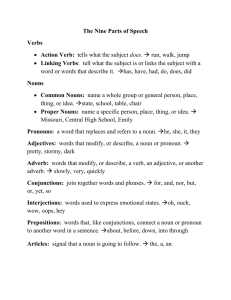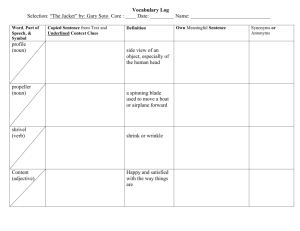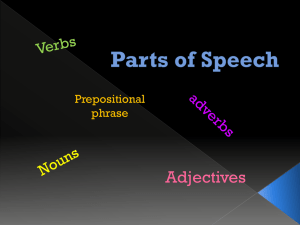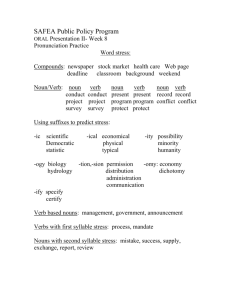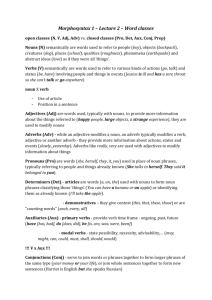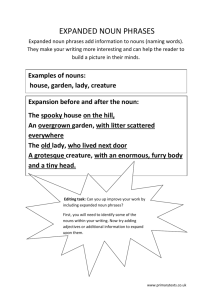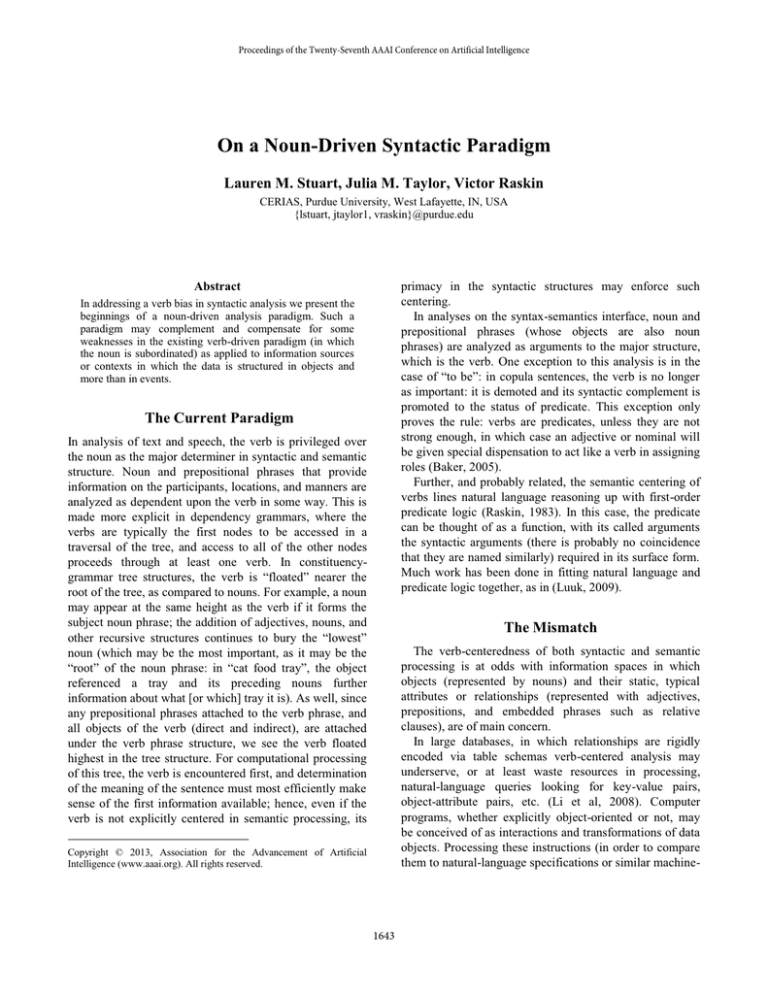
Proceedings of the Twenty-Seventh AAAI Conference on Artificial Intelligence
On a Noun-Driven Syntactic Paradigm
Lauren M. Stuart, Julia M. Taylor, Victor Raskin
CERIAS, Purdue University, West Lafayette, IN, USA
{lstuart, jtaylor1, vraskin}@purdue.edu
primacy in the syntactic structures may enforce such
centering.
In analyses on the syntax-semantics interface, noun and
prepositional phrases (whose objects are also noun
phrases) are analyzed as arguments to the major structure,
which is the verb. One exception to this analysis is in the
case of “to be”: in copula sentences, the verb is no longer
as important: it is demoted and its syntactic complement is
promoted to the status of predicate. This exception only
proves the rule: verbs are predicates, unless they are not
strong enough, in which case an adjective or nominal will
be given special dispensation to act like a verb in assigning
roles (Baker, 2005).
Further, and probably related, the semantic centering of
verbs lines natural language reasoning up with first-order
predicate logic (Raskin, 1983). In this case, the predicate
can be thought of as a function, with its called arguments
the syntactic arguments (there is probably no coincidence
that they are named similarly) required in its surface form.
Much work has been done in fitting natural language and
predicate logic together, as in (Luuk, 2009).
Abstract
In addressing a verb bias in syntactic analysis we present the
beginnings of a noun-driven analysis paradigm. Such a
paradigm may complement and compensate for some
weaknesses in the existing verb-driven paradigm (in which
the noun is subordinated) as applied to information sources
or contexts in which the data is structured in objects and
more than in events.
The Current Paradigm
In analysis of text and speech, the verb is privileged over
the noun as the major determiner in syntactic and semantic
structure. Noun and prepositional phrases that provide
information on the participants, locations, and manners are
analyzed as dependent upon the verb in some way. This is
made more explicit in dependency grammars, where the
verbs are typically the first nodes to be accessed in a
traversal of the tree, and access to all of the other nodes
proceeds through at least one verb. In constituencygrammar tree structures, the verb is “floated” nearer the
root of the tree, as compared to nouns. For example, a noun
may appear at the same height as the verb if it forms the
subject noun phrase; the addition of adjectives, nouns, and
other recursive structures continues to bury the “lowest”
noun (which may be the most important, as it may be the
“root” of the noun phrase: in “cat food tray”, the object
referenced a tray and its preceding nouns further
information about what [or which] tray it is). As well, since
any prepositional phrases attached to the verb phrase, and
all objects of the verb (direct and indirect), are attached
under the verb phrase structure, we see the verb floated
highest in the tree structure. For computational processing
of this tree, the verb is encountered first, and determination
of the meaning of the sentence must most efficiently make
sense of the first information available; hence, even if the
verb is not explicitly centered in semantic processing, its
The Mismatch
The verb-centeredness of both syntactic and semantic
processing is at odds with information spaces in which
objects (represented by nouns) and their static, typical
attributes or relationships (represented with adjectives,
prepositions, and embedded phrases such as relative
clauses), are of main concern.
In large databases, in which relationships are rigidly
encoded via table schemas verb-centered analysis may
underserve, or at least waste resources in processing,
natural-language queries looking for key-value pairs,
object-attribute pairs, etc. (Li et al, 2008). Computer
programs, whether explicitly object-oriented or not, may
be conceived of as interactions and transformations of data
objects. Processing these instructions (in order to compare
them to natural-language specifications or similar machine-
Copyright © 2013, Association for the Advancement of Artificial
Intelligence (www.aaai.org). All rights reserved.
1643
language programs) may, if the processing module is verbdriven, fail to account for object-based polymorphisms, or
accommodate them at high cost.
Less-structured information repositories may also
exhibit some bias toward the presentation of information in
noun phrases, prepositional phrases, relative phrases, and
weak verbs. Some of these sources we might assume have
a semantic bias towards the definitions of objects, types,
and typical relationships. For instance, an introductory
article on geography may describe types and typical
qualities and positions of geographical features in noun
phrases and prepositional phrases, while a geographical
history of a particular location may be more concerned
with geographical events and exploration (action). Even
then, the latter article will contain references to places
(objects/nouns). Note through this article that events also
manifest syntactically as nouns (e.g., “events”); the pairing
of noun/object and verb/event is not so rigid, as many
verb-concepts can be expressed as nouns.
phrases proceed outward from the word that they can be
best said to modify, from nouns or verbs as appropriate.
The noun object of a preposition is the only noun in this
representation that does not dominate all of its
relationships; the preposition dominates it so that we may
establish a path from one root noun to the root noun of the
prepositional phrase that further characterizes it.
Preliminary analysis of such a noun-centered
dependency syntax representation suggests that it performs
better (in terms of complexity of access of certain
categories of words) than verb-driven representations
derived from the same texts (Stuart et al, 2012).
The central tenet of the paradigm can undoubtedly be
bent in many different directions. Future work will include
investigation of the complexity and space tradeoffs
between noun-driven dependency-like representations and
constituency-like representations, after determination of
how the latter might work from a noun-driven perspective.
Another major question is whether a verb-driven or noundriven syntax in particular is better suited to use with
knowledge systems (in, say, processing large amounts of
natural language data for summarization, reasoning, or
learning) whose architectures may be more object- or
event-centered. Hybrid spaces or systems may also benefit
from using both paradigms in tandem.
Rectification of the mismatch – that is, restoring the
noun to a place of importance in syntactic analysis –
potentially improves natural language interaction between
humans and non-human systems whose primary concerns
are objects (physical or informational), their attributes, and
their interactions.
A Proposal
In an attempt to address this inequity – the dominance of
verb-centered analysis – we introduce a beginning noundriven syntactic analysis. The noun-driven syntax
representation is only a part of the whole equation: the
verb-centered paradigm has years of theory, application,
and intuition, which each interact to re-entrench the
paradigm. We present a first step in establishing a
complementary paradigm for the noun, intending toward
an object- rather than event-based semantic analysis.
The representation borrows from dependency grammars:
the syntactic tree is mapped in terms of directional binary
relationships between words (see Figure 1). In this case,
the nouns are (with one exception) dominators of the
(dependency-like) relationships. Links to adjectives,
determiners, and other nouns in the noun phrase proceed
outwards from the root noun, which we already expect
from dependency grammar, as they depend upon the noun.
References
Baker, Mark. 2005. Lexical Categories: Verbs, Nouns, and
Adjectives. Cambridge: Cambridge University Press.
Li, Zhanjun, Victor Raskin, and Karthik Ramani. "Developing
Engineering Ontology for Information Retrieval." Journal of
Computing and Information Science in Engineering 8(1):01100313 (2008).
Luuk, Erkki. 2009. The noun/verb and predicate/argument
structures. Lingua 119 (2009): 1707–1727.
Figure 1 A noun-driven syntax representation.
Raskin, Victor. 1983. A Concise History of Linguistic Semantics
Pt 1. Unpublished manuscript. Department of Linguistics, Purdue
University, West Lafayette, IN.
However, the linkage of the nouns with the verbs has a
reversed polarity: verbs depend upon the nouns. The
number of noun phrase arguments to a verb is thus the
number of incoming connections from nouns. Prepositional
Stuart, Lauren M., Julia M. Taylor, and Victor Raskin. 2012.
Towards Noun-Driven Parsing. In Proceedings of 2012 IEEE
International Conference on Systems, Man, and Cybernetics
(SMC) 1984-1989. Seoul, South Korea.
1644

